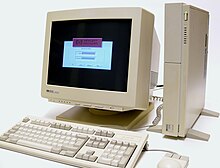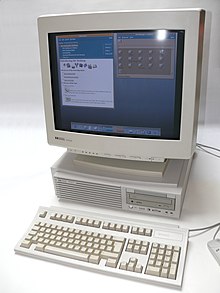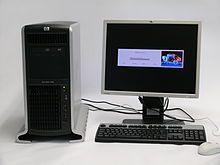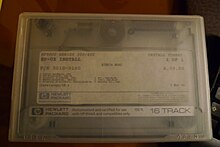
AIX is a series of proprietary Unix operating systems developed and sold by IBM for several of its computer platforms.

Itanium is a discontinued family of 64-bit Intel microprocessors that implement the Intel Itanium architecture. The Itanium architecture originated at Hewlett-Packard (HP), and was later jointly developed by HP and Intel. Launched in June 2001, Intel initially marketed the processors for enterprise servers and high-performance computing systems. In the concept phase, engineers said "we could run circles around PowerPC...we could kill the x86." Early predictions were that IA-64 would expand to the lower-end servers, supplanting Xeon, and eventually penetrate into the personal computers, eventually to supplant reduced instruction set computing (RISC) and complex instruction set computing (CISC) architectures for all general-purpose applications.

Precision Architecture RISC (PA-RISC) or Hewlett Packard Precision Architecture, is a general purpose computer instruction set architecture (ISA) developed by Hewlett-Packard from the 1980s until the 2000s.

OpenVMS, often referred to as just VMS, is a multi-user, multiprocessing and virtual memory-based operating system. It is designed to support time-sharing, batch processing, transaction processing and workstation applications. Customers using OpenVMS include banks and financial services, hospitals and healthcare, telecommunications operators, network information services, and industrial manufacturers. During the 1990s and 2000s, there were approximately half a million VMS systems in operation worldwide.
IA-64 is the instruction set architecture (ISA) of the discontinued Itanium family of 64-bit Intel microprocessors. The basic ISA specification originated at Hewlett-Packard (HP), and was subsequently implemented by Intel in collaboration with HP. The first Itanium processor, codenamed Merced, was released in 2001.

In computer architecture, 64-bit integers, memory addresses, or other data units are those that are 64 bits wide. Also, 64-bit central processing units (CPU) and arithmetic logic units (ALU) are those that are based on processor registers, address buses, or data buses of that size. A computer that uses such a processor is a 64-bit computer.

Apollo Computer Inc., founded in 1980 in Chelmsford, Massachusetts, by William Poduska and others, developed and produced Apollo/Domain workstations in the 1980s. Along with Symbolics and Sun Microsystems, Apollo was one of the first vendors of graphical workstations in the 1980s. Like computer companies at the time and unlike manufacturers of IBM PC compatibles, Apollo produced much of its own hardware and software.
Tandem Computers, Inc. was the dominant manufacturer of fault-tolerant computer systems for ATM networks, banks, stock exchanges, telephone switching centers, 911 systems, and other similar commercial transaction processing applications requiring maximum uptime and zero data loss. The company was founded by Jimmy Treybig in 1974 in Cupertino, California. It remained independent until 1997, when it became a server division within Compaq. It is now a server division within Hewlett Packard Enterprise, following Hewlett-Packard's acquisition of Compaq and the split of Hewlett-Packard into HP Inc. and Hewlett Packard Enterprise.
In computing, binary translation is a form of binary recompilation where sequences of instructions are translated from a source instruction set to the target instruction set. In some cases such as instruction set simulation, the target instruction set may be the same as the source instruction set, providing testing and debugging features such as instruction trace, conditional breakpoints and hot spot detection.
OSF/1 is a variant of the Unix operating system developed by the Open Software Foundation during the late 1980s and early 1990s. OSF/1 is one of the first operating systems to have used the Mach kernel developed at Carnegie Mellon University, and is probably best known as the native Unix operating system for DEC Alpha architecture systems.

Unix System V is one of the first commercial versions of the Unix operating system. It was originally developed by AT&T and first released in 1983. Four major versions of System V were released, numbered 1, 2, 3, and 4. System V Release 4 (SVR4) was commercially the most successful version, being the result of an effort, marketed as Unix System Unification, which solicited the collaboration of the major Unix vendors. It was the source of several common commercial Unix features. System V is sometimes abbreviated to SysV.
Trusted Operating System (TOS) generally refers to an operating system that provides sufficient support for multilevel security and evidence of correctness to meet a particular set of government requirements.

The HP 3000 series is a family of 16-bit and 32-bit minicomputers from Hewlett-Packard. It was designed to be the first minicomputer with full support for time-sharing in the hardware and the operating system, features that had mostly been limited to mainframes, or retrofitted to existing systems like Digital's PDP-11, on which Unix was implemented. First introduced in 1972, the last models reached end-of-life in 2010, making it among the longest-lived machines of its generation.

HP 9000 is a line of workstation and server computer systems produced by the Hewlett-Packard (HP) Company. The native operating system for almost all HP 9000 systems is HP-UX, which is based on UNIX System V.
HPE Integrity Servers is a series of server computers produced by Hewlett Packard Enterprise since 2003, based on the Itanium processor. The Integrity brand name was inherited by HP from Tandem Computers via Compaq.
Integrity Virtual Machines is a hypervisor from Hewlett Packard Enterprise for HPE Integrity Servers running HP-UX. It is part of HP's Virtual Server Environment suite, and is optimized for server use.
In computing, the System Object Model (SOM) is a proprietary executable file format developed by Hewlett-Packard for its HP-UX and MPE/ix operating systems. In particular, SOM is the native format used for 32-bit application executables, object code, and shared libraries running under the PA-RISC family of processors.
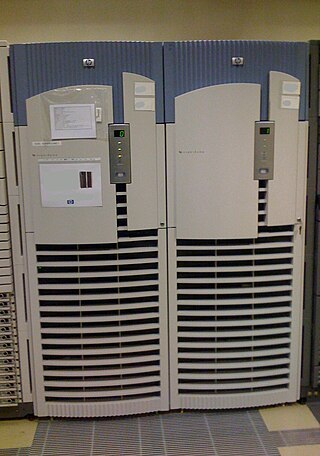
The HP Superdome is a high-end server computer designed and manufactured by Hewlett Packard Enterprise. The product's most recent version, "Superdome 2," was released in 2010 supporting 2 to 32 sockets and 4 TB of memory. The Superdome used PA-RISC processors when it debuted in 2000. Since 2002, a second version of the machine based on Itanium 2 processors has been marketed as the HP Integrity Superdome.
ptrace is a system call found in Unix and several Unix-like operating systems. By using ptrace one process can control another, enabling the controller to inspect and manipulate the internal state of its target. ptrace is used by debuggers and other code-analysis tools, mostly as aids to software development.


